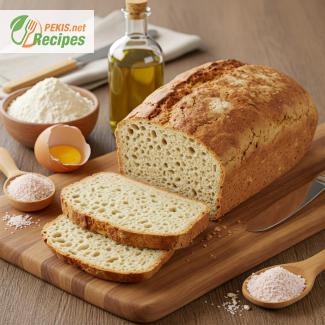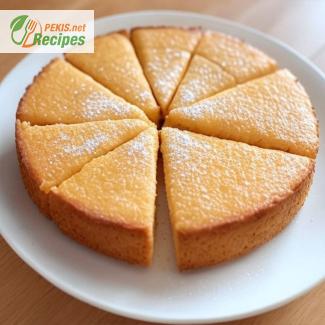
The Best Soft and Fluffy Gluten-Free Bread
A Delicious Homemade Bread Without Gluten
For those who follow a gluten-free diet, finding a truly satisfying and soft gluten-free bread can be a challenge. Many store-bought options are dry, crumbly, or filled with unnecessary additives. However, making your own homemade gluten-free bread can be a game-changer, allowing you to enjoy a fluffy, golden-crusted loaf with a perfect texture and taste.
This gluten-free bread recipe is not only easy to follow but also delivers a bakery-quality result. It features a light and airy crumb, a crispy crust, and a slightly nutty flavor that pairs beautifully with both sweet and savory toppings. Whether you need a satisfying slice for breakfast, a sandwich for lunch, or a comforting piece of toast in the evening, this bread will quickly become a staple in your kitchen.
Unlike traditional wheat-based bread, gluten-free baking requires a special blend of ingredients to achieve the perfect balance of softness and structure. The right combination of gluten-free flour, binding agents, and leavening techniques ensures that the final product is not only delicious but also holds together well without being overly dense or dry.
Why This Gluten-Free Bread is Different
Soft and Moist Texture
Many gluten-free bread recipes result in a dense and dry loaf, but this one is designed to be light, fluffy, and moist. The secret lies in using the right gluten-free flour blend combined with ingredients like psyllium husk, xanthan gum, or eggs, which help mimic the elasticity of gluten.
Golden, Crispy Crust
If you've been missing that satisfying crunch when biting into freshly baked bread, this recipe brings it back! The addition of olive oil or butter creates a beautifully golden crust, making each slice irresistible.
Simple and Beginner-Friendly
You don’t need to be a professional baker to achieve great results. This easy gluten-free bread recipe requires just a few simple steps and doesn't demand any complicated techniques. Whether you are new to baking or an experienced home cook, you can make this delicious loaf with ease.
Key Ingredients for the Perfect Gluten-Free Loaf
Gluten-Free Flour Blend
A high-quality gluten-free flour mix is crucial for the success of this bread. The best blends include a combination of rice flour, tapioca flour, and potato starch to create a balanced structure and softness.
Binding Agents for Elasticity
Since gluten is responsible for the chewiness in regular bread, replacing it with xanthan gum or psyllium husk ensures that the dough holds together well and doesn't fall apart.
Yeast and Leavening for the Perfect Rise
Using active dry yeast or instant yeast gives the bread its airy texture. A little bit of baking powder can also help create a nice lift, ensuring the loaf rises properly.
Moisture-Retaining Ingredients
To prevent dryness, eggs, milk, or dairy-free alternatives like almond milk add richness and keep the bread from becoming too brittle. Some recipes also use honey or a touch of sugar to enhance both flavor and moisture retention.
How to Enjoy This Gluten-Free Bread
Freshly Baked and Warm
Nothing beats the taste of freshly baked bread, especially when it’s still slightly warm. Spread it with butter, jam, or a drizzle of honey for a comforting treat.
Perfect for Sandwiches
Since this gluten-free loaf has a soft yet sturdy texture, it holds up beautifully in sandwiches. Whether you prefer classic ham and cheese, avocado toast, or a gourmet veggie sandwich, this bread is the perfect base.
Toasted for Extra Crunch
Toasting brings out even more flavor and texture. Top a slice with cream cheese, smoked salmon, or peanut butter for a delicious breakfast or snack.
This homemade gluten-free bread proves that avoiding gluten doesn’t mean giving up on delicious, high-quality bread. With the right ingredients and techniques, you can enjoy a loaf that is just as satisfying—if not better—than traditional wheat bread. Whether you follow a gluten-free lifestyle due to dietary restrictions or simply enjoy trying new recipes, this bread is sure to become a favorite in your kitchen.
- Activating the yeast: In a small bowl, combine warm water, sugar, and yeast. Stir gently and let it sit for 10 minutes until frothy.
- Mixing dry ingredients: In a large mixing bowl, whisk together gluten-free flour blend, psyllium husk, xanthan gum, and salt.
- Combining wet ingredients: In a separate bowl, whisk eggs, olive oil, and apple cider vinegar.
- Forming the dough: Pour the yeast mixture and egg mixture into the bowl with dry ingredients. Mix using a stand mixer with a dough hook or a hand mixer with dough attachments for about 5 minutes until smooth. The dough will be slightly sticky but thick.
- First rise: Transfer the dough into a greased bread pan, cover with a damp towel, and let it rise in a warm place for 45 minutes or until doubled in size.
- Baking the bread: Preheat the oven to 180°C (350°F). Place the risen dough in the oven and bake for 50 minutes until golden brown.
- Cooling: Remove the bread from the oven and let it cool in the pan for 10 minutes before transferring it to a wire rack. Allow to cool completely before slicing.
Enhancing Your Gluten-Free Bread for the Best Flavor and Texture
Key Adjustments to Make Gluten-Free Bread Even Better
Baking homemade gluten-free bread can be incredibly rewarding, but it also comes with challenges. Achieving the perfect texture, flavor, and crust requires a delicate balance of ingredients and techniques. By making thoughtful adjustments, you can significantly enhance the taste and structure of your bread, ensuring a consistently excellent loaf every time.
Choosing the Right Flour Blend
Importance of a Balanced Flour Mix
Since gluten-free bread lacks the natural elasticity of wheat-based dough, using the right flour combination is crucial. A single type of flour often results in a dense and dry loaf. Instead, a blend of different gluten-free flours can create the ideal texture.
Best Flour Combinations
- Rice flour + tapioca starch + potato starch: This trio forms the base of many gluten-free blends, providing lightness and structure.
- Almond flour: Adds a slightly nutty flavor and contributes to a softer crumb.
- Oat flour: Enhances the moisture retention and adds mild sweetness.
- Sorghum flour: Introduces a subtle earthy taste and helps with elasticity.
Experimenting with different combinations can help achieve the perfect balance between softness and structure.
Improving Moisture and Elasticity
Adding Psyllium Husk or Flaxseed
One of the biggest challenges in gluten-free bread is moisture retention. Without gluten, the dough tends to dry out faster. Adding psyllium husk or ground flaxseed can significantly improve the moisture and texture, making the bread less crumbly and more flexible.
- Psyllium husk (5-10 g): Helps create a gel-like texture, mimicking gluten’s elasticity.
- Ground flaxseed (1-2 tbsp mixed with water): Acts as a natural binder, keeping the loaf from falling apart.
Increasing Fat Content
A small increase in healthy fats can improve both softness and shelf life. Adding extra olive oil, butter, or even avocado oil can prevent the bread from becoming too dry.
- Coconut oil: Provides a slight sweetness and helps keep the bread fresh longer.
- Olive oil: Adds depth to the flavor while maintaining a moist crumb.
- Greek yogurt: Can be used for extra creaminess and tenderness.
Enhancing the Flavor Profile
Using Natural Sweeteners
Traditional gluten-free bread can sometimes taste bland. Introducing natural sweeteners enhances the overall taste while maintaining balance.
- Honey or maple syrup (1 tbsp): Adds a mild sweetness and helps with browning.
- Molasses (½ tsp): Deepens the flavor complexity and boosts yeast activity.
Infusing Additional Ingredients
For a more complex and appealing flavor, consider adding small amounts of:
- Herbs (rosemary, thyme, oregano): Enhance the aroma and taste.
- Garlic powder or onion powder: Provides a savory depth.
- Sunflower or pumpkin seeds: Add texture and nuttiness.
Common Mistakes and How to Avoid Them
Using Too Much or Too Little Liquid
Gluten-free dough often requires more hydration than wheat-based dough. However, adding too much water can make the bread gummy, while too little can result in a hard, dense texture.
- Ensure your liquid ratio is balanced, and always check the dough consistency before baking.
Not Allowing Enough Rising Time
Gluten-free bread needs extra time to fully rise since the structure is weaker than traditional dough. Rushing the proofing process can result in a flat, dense loaf.
- Let the dough rest for at least 45-60 minutes in a warm environment to ensure proper aeration.
Skipping the Binding Agents
Without gluten, the bread needs binders to prevent it from falling apart. Neglecting ingredients like xanthan gum, psyllium husk, or flaxseed can result in a crumbly and dry loaf.
- Always include a stabilizer to maintain a proper structure.
Healthier Alternatives for a More Nutritious Bread
Substituting Regular Flour with Whole-Grain Options
For a more nutritious version, replace a portion of the starchy flour with whole-grain gluten-free options:
- Buckwheat flour: Rich in fiber and antioxidants.
- Quinoa flour: Packed with protein and essential amino acids.
- Teff flour: Provides iron and calcium, supporting bone health.
Reducing Sodium Content
To make your bread healthier, you can reduce sodium without compromising flavor:
- Use sea salt or Himalayan salt instead of refined salt.
- Add herbs or spices to enhance the taste naturally.
Lowering Sugar Content
If you want to minimize sugar intake:
- Replace sugar with unsweetened applesauce or a few drops of stevia.
- Opt for coconut sugar, which has a lower glycemic index.
Why Homemade Gluten-Free Bread is Superior
Fewer Preservatives and Additives
Store-bought gluten-free bread often contains preservatives, artificial flavors, and excessive starches to prolong shelf life. By making your own, you control every ingredient and nutritional value.
Cost-Effective and Customizable
Baking at home allows for ingredient customization based on personal taste and dietary preferences, often at a lower cost than purchasing specialty loaves.
Freshness and Flavor
Nothing compares to the taste and aroma of freshly baked bread. Store-bought varieties are often pre-packaged and lack texture, whereas homemade bread is soft, fresh, and full of natural flavors.
By implementing these enhancements and adjustments, you can elevate your gluten-free bread to an entirely new level. Whether you aim for a better texture, richer flavor, or healthier ingredients, small changes make a significant impact. Experimenting with these techniques ensures that every loaf turns out light, delicious, and satisfying.
This recipe is gluten-free, but contains eggs. For an egg-free version, replace the eggs with 60 ml (¼ cup) unsweetened applesauce or 2 flax eggs (2 tbsp flaxseed meal + 6 tbsp water, mixed and left for 10 minutes to thicken).
- Vitamin B1 (Thiamine): 0.1 mg (important for energy metabolism)
- Vitamin B6: 0.08 mg (supports brain health and immune function)
- Magnesium: 12 mg (contributes to muscle and nerve function)
- Iron: 0.9 mg (essential for red blood cell production)
- Zinc: 0.4 mg (boosts immunity and wound healing)
- Polyphenols: 15 mg per slice (help protect cells from oxidative stress)
- Vitamin E: 0.3 mg per slice (supports skin health and immune defense)
This homemade gluten-free bread is soft, flavorful, and perfect for anyone avoiding gluten. Enjoy it fresh, toasted, or as a base for sandwiches while still benefiting from its rich nutritional profile.
Recipes worth trying
Liquid rennet is a culinary treasure and an essential ingredient in the world of cheesemaking, revered by both professionals and home cooks alike. This natural coagulant plays a pivotal role in…
As the holiday season approaches, the comforting aroma of freshly baked bread fills kitchens around the world, becoming a symbol of togetherness and indulgence. For those embracing a gluten-free…
Keto Peanut Butter Cookies – A Guilt-Free Indulgence
The Perfect Balance of Flavor and NutritionIf you’re following a keto diet, you know how difficult it can be to find a dessert that is…
Gluten-free baking may sound intimidating, but this simple 5-ingredient dessert proves it doesn’t have to be. In just a few easy steps, you’ll have a delectable treat that’s not only free of…
Indulge in the Magic of the Holiday Season with Gluten-Free Christmas Cookies
The holiday season is a time for cherished moments, warm gatherings, and delightful treats. One of the most…
The gluten-free cake biscuit is a light and airy base that opens up a world of possibilities for dessert creations. This gluten-free foundation allows anyone, from professional bakers to…





